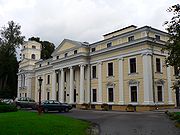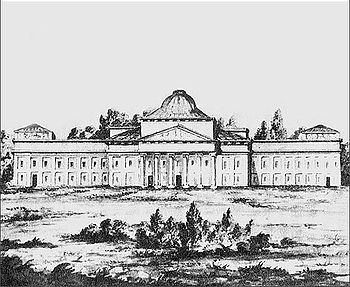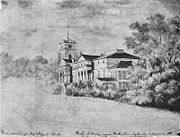
Verkiai Palace
Encyclopedia

Neoclassical architecture
Neoclassical architecture was an architectural style produced by the neoclassical movement that began in the mid-18th century, manifested both in its details as a reaction against the Rococo style of naturalistic ornament, and in its architectural formulas as an outgrowth of some classicizing...
mansion in Verkiai
Verkiai
Verkiai is a northernmost eldership in Vilnius, Lithuania. Historically it was a separate settlement situated north of Vilnius but today it is a part of Vilnius city municipality. It occupies 5,565 ha and has 30,000 inhabitants...
, Vilnius
Vilnius
Vilnius is the capital of Lithuania, and its largest city, with a population of 560,190 as of 2010. It is the seat of the Vilnius city municipality and of the Vilnius district municipality. It is also the capital of Vilnius County...
, Lithuania
Lithuania
Lithuania , officially the Republic of Lithuania is a country in Northern Europe, the biggest of the three Baltic states. It is situated along the southeastern shore of the Baltic Sea, whereby to the west lie Sweden and Denmark...
.
History
Until the end of 14th century this place was a property of the Grand Dukes of Lithuania. There was a wooden manor even in 13th century. In 1387 Lithuanian Grand Duke JogailaJogaila
Jogaila, later 'He is known under a number of names: ; ; . See also: Jogaila : names and titles. was Grand Duke of Lithuania , king consort of Kingdom of Poland , and sole King of Poland . He ruled in Lithuania from 1377, at first with his uncle Kęstutis...
, on occasion of accepting Christianity, donated this place to Vilnius' Episcopate
Archdiocese of Vilnius
The Roman Catholic Metropolitan Archdiocese of Vilnius is an ecclesiastical territory or diocese of the Roman Catholic Church in Lithuania. Established as the Diocese of Vilnius in the 14th century, it was elevated to the rank of a metropolitan archdiocese by Pope Pius XI on October 28, 1925...
. Verkiai served as the permanent summer residence of Vilnius bishops until the end of 18 century.

Ignacy Jakub Massalski
Prince Ignacy Massalski was a Polish-Lithuanian nobleman.Ignacy was Bishop of Vilnius and one of the initiators of the Commission for National Education. After few years he was removed from the Commission for embezzlement of public funds...
took over it in 1780. He hired two famous architects, Marcin Knackfus
Marcin Knackfus
Marcin Knackfus was a Polish–Lithuanian Neoclassical architect of German descent. Born near Warsaw, he worked in the Grand Duchy of Lithuania and particularly in its capital Vilnius...
and Laurynas Gucevičius
Laurynas Gucevicius
Laurynas Gucevičius was an 18th century architect born in the Polish-Lithuanian Commonwealth, the Grand Duchy of Lithuania, and most of his designs were built there....
, to rebuild the palace in the Neoclassical
Neoclassical architecture
Neoclassical architecture was an architectural style produced by the neoclassical movement that began in the mid-18th century, manifested both in its details as a reaction against the Rococo style of naturalistic ornament, and in its architectural formulas as an outgrowth of some classicizing...
style. The general plan and maintenance buildings were designed by Marcin Knackfus. The main palace building, the stables and several other buildings were designed by Gucevičius. The building was called "the Versailles of Vilnius". The palace had a little theatre, large library, and a small gun museum and was surrounded by a park.

Napoleon I of France
Napoleon Bonaparte was a French military and political leader during the latter stages of the French Revolution.As Napoleon I, he was Emperor of the French from 1804 to 1815...
's invasion of Russia. Eventually, the central building of the palace was pulled down on the order of a new owner, prince Ludwig Wittgenstein
Ludwig zu Sayn-Wittgenstein-Berleburg
Prince Ludwig Adolf Friedrich of Sayn-Wittgenstein was a Russian aristocrat of German descent...
, who bought Verkiai in 1839. He also ordered restructuring the other buildings and the east wing office house assumed the role of the palace since the 1840s. It is attested that the first known photograph
Photograph
A photograph is an image created by light falling on a light-sensitive surface, usually photographic film or an electronic imager such as a CCD or a CMOS chip. Most photographs are created using a camera, which uses a lens to focus the scene's visible wavelengths of light into a reproduction of...
s in present-day Lithuania were taken there in 1839, when Karol Podczaszyński
Karol Podczaszynski
Karol Podczaszyński was a Polish-Lithuanian architect, a representative of the neoclassical architecture and a professor of the Imperial University of Vilna, as well as one of the pioneers of industrial design....
made a daguerreotype
Daguerreotype
The daguerreotype was the first commercially successful photographic process. The image is a direct positive made in the camera on a silvered copper plate....
of the palace which was intended to be rebuilt. The images have not survived.
After World War II
World War II
World War II, or the Second World War , was a global conflict lasting from 1939 to 1945, involving most of the world's nations—including all of the great powers—eventually forming two opposing military alliances: the Allies and the Axis...
, the remaining palace buildings were used as educational institutions and an art museum. Since 1960 the ensemble belongs to the Lithuanian Academy of Sciences
Lithuanian Academy of Sciences
The Lithuanian Academy of Sciences or LAS, founded in 1941 as the Lithuanian SSR Academy of Sciences , as an autonomous, state-subsidized establishment serving as a scientific advisory body to the government of Lithuanian SSR...
Institute of Botany. Verkiai Palace complex is an important cultural and historical landmark in Verkiai Regional Park
Verkiai Regional Park
Verkiai Regional Park is one of the Regional Parks in Lithuania. It is located almost entirely in Verkiai elderate of Vilnius municipality.The park was established in 1992 in order to protect natural complexes of the Green Lakes and cultural complexes of Verkiai Palace and a park, Kalvarijos and...
.

